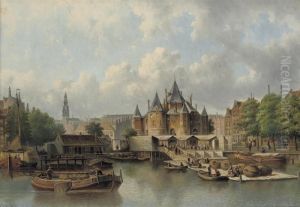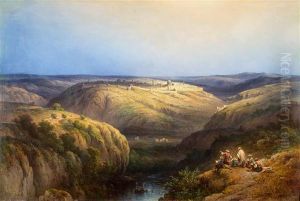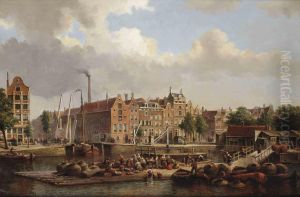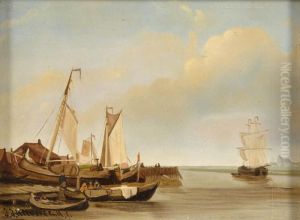Johann Jakob Anton Hilverdink Paintings
Johann Jakob Anton Hilverdink was a notable 19th-century Dutch artist, born in 1813 in Amsterdam and passing away in 1902. His artistic journey is a reflection of the vibrant art scene of the Netherlands during his lifetime, which was marked by a rich tradition of painting that stretched back to the Dutch Golden Age. Hilverdink was primarily known for his landscape and cityscape paintings, capturing the essence of Dutch life, architecture, and the natural beauty of his homeland with a keen eye for detail and a profound appreciation for the interplay of light and color.
Educated in the arts from a young age, Hilverdink showed an early talent for drawing and painting. Although specific details about his education are scarce, it is known that he was part of a milieu that valued artistic achievement and innovation. Throughout his career, Hilverdink participated in the broader European art movements of the time, drawing inspiration from Romanticism, which emphasized emotion and individualism, as well as from Realism, with its focus on depicting everyday life and society with truth and accuracy.
Hilverdink's works were well received during his lifetime, allowing him to gain a respectable reputation not only among his contemporaries in the Netherlands but also with an international audience. He exhibited his works in various art shows and salons, contributing to the cultural exchange of ideas and artistic techniques across Europe. His paintings often featured the Dutch countryside, including its canals, ships, and urban scenes, rendered with meticulous attention to atmospheric effects and the changing qualities of light. These works not only showcased his technical skill but also his ability to evoke a sense of nostalgia and serenity, capturing moments in time with both realism and emotional depth.
Despite his success, Johann Jakob Anton Hilverdink remains a somewhat lesser-known figure outside of the Netherlands, overshadowed by some of his more famous contemporaries. Yet, his contribution to the Dutch art world of the 19th century is undeniable, offering insights into the cultural and social dynamics of his time. Today, his paintings can be found in various art collections, museums, and galleries, appreciated by those who seek to understand the depth and diversity of 19th-century Dutch art.



